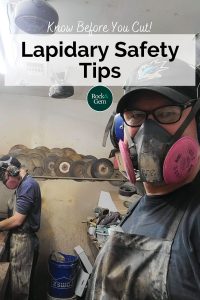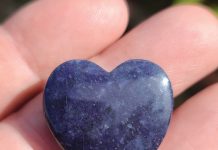
Lapidary safety tips should be followed before a grinding machine is turned on and used. It’s important to know what is being cut and what health hazards might be associated with it. Many lapidaries start in the profession as a hobby, either by watching others or by teaching themselves. One thing that can be missing in this training is learning safety procedures.

Over the years I have heard many people in the rock community say they will never cut certain stones because of all the inherent dangers that are contained within the material. The reality is the dangers are not in handling the materials themselves but in the processing. The dangers can easily be handled with proper education, gaining knowledge of what is in each stone before cutting, and how to properly stay out of harm’s way with the correct protective gear.
Dangerous Materials
Many stones used in lapidary work may contain radioactive minerals, asbestos, beryllium, sulfur, cinnabar (mercury), and various other harmful elements that can cause health problems if not handled properly. Everything can have risks, even some common items around the house have potential risks — smoke detectors contain radioactive elements, ceramics like tiles and pottery may contain uranium in the glazes, and for years, dishware had radioactive minerals used in the bright coloring. People are familiar with these materials and are comfortable having them around because they know the proper precautions are taken so they can be used as everyday items. The same can be said with many common lapidary materials.

Stones like pietersite, tiger’s eye, marra mamba, and serpentine contain asbestos. Society has been trying to remove old asbestos-containing products such as insulation in homes and buildings for years. This is because asbestos is a fine fiber mineral that when turned into dust and goes airborne, has been linked to lung cancer, mesothelioma, and asbestosis. Stones like Clear Creek plasma agate contain various minerals, one of them being an attractive bright red cinnabar which is a mercury sulfide and can be dangerous if you breathe in the dust. It is most dangerous though when breathing in the fumes when the stone is heated to over 400°F. Mercury was utilized by gold miners in the extraction process of gold from the quartz host stone. Members of the quartz mineral group, one of the most common materials and contained in the majority of lapidary materials, is known to cause silicosis. Silicosis is a lung disease caused by inhaling large amounts of crystalline silica dust. It is not curable but is very preventable.
Lapidary Precautions
When cutting cabochons, it’s important to know which materials are unsafe to handle, but for the most part, the majority can be cut with the right precautions. First, setting up your workspace with proper ventilation is key. Everything you do should protect your breathing.
Next, wearing rubber latex gloves or nitrile gloves to protect from skin irritations is not a bad practice. It might not always be effective for those who like to hold the stones by hand as they cab because the gloves tend to rip easily when close to the wheels. If you cab using dop sticks, these gloves can help keep your skin from being overly exposed.
Eye gear is ALWAYS warranted, not just for avoiding the collection of dust particles in your eyes, but to also protect from small chips and shards flying off the grinding wheels that can cause a great deal of eye damage.
The number one article of gear that should ALWAYS be worn is a respiratory mask. The N95 might be adequate for most things. (The 95 number stands for 95 percent of all dust particles.) However, I would suggest using the P100 mask with replaceable filters. These masks will block out 100 percent of all particles in the air and protect you from harmful dust.
A waterproof apron will keep you dry and keep lapidary materials off your clothing. Ear guards not only protect your hearing by blocking machine noise, but they also keep your ears clean and free from compiling dust or particles.

Clean Work Surfaces
In addition to wearing protective gear, keeping a clean shop is just as important. If you are cutting up materials that contain carcinogens such as Tiffany stone which contains beryllium, always clean all the surfaces in your workspace where dust has collected. This way, there won’t be a transfer of dust to your hands, and will avoid accidental ingestion later.
A complete set of protective gear includes a P100 respirator, eye protection, ear protection, a waterproof apron, and gloves. All these items can easily be found at your local stores, such as Home Depot, Lowes or Ace Hardware, and online on Amazon and eBay. Wearing all the correct protective gear and keeping a clean work area should help ensure a safe, healthy hobby.
This story about lapidary safety tips previously appeared in Rock & Gem magazine. Click here to subscribe. Story by Russ Kaniuth.












